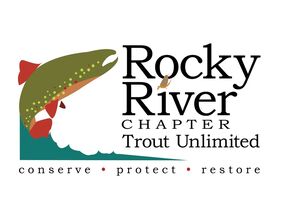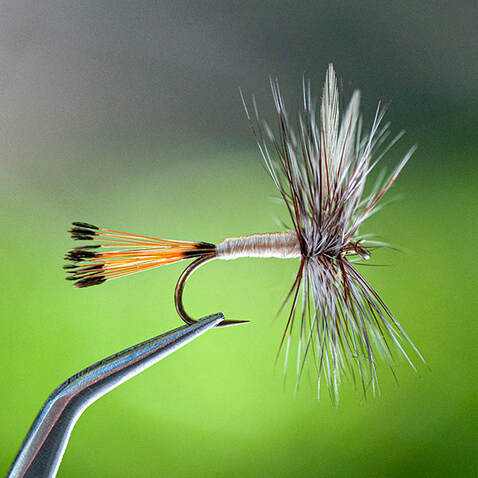Fly of the Month 01.24 Hazel Creek [Dry Fly]
This “fly of the month” represents an original Southern Appalachian dry fly created by a special fly tyer who is still in practice, still guiding customers and living western North Carolina in the midst of our North Carolina trout waters. Yes, living in paradise and always in pursuit of trout!
That special fly tyer is Roger Lowe. Before the turn of the century and for many years, Roger owned and operated his fly shop, the Lowe Fly Shop in Waynesville, North Carolina where he provided custom guide services in both wade trips and float trips. As Roger looked toward retiring at some point, he decided to sell and close shop, then join Brookings’ Cashiers Village Outfitters - Fly Fishing Shops. Roger continues to share his experience and wisdom with fly fishing anglers practical every day.
“The Hazel Creek [Dry Fly] is an attractor fly I designed in the late-1990s to be fished spring and summer to look like various mayflies seen on streams in western North Carolina.” - Roger Lowe
Roger designed the Hazel Creek fly pattern in the late-1990s. Hazel Creek was the first stream where it was tried successfully, catching fish and earning the namesake of the stream. However, it has been found effective for wild trout throughout the Great Smoky Mountains National Park. To date there have been no variations, just the same original which was sold both in Roger’s fly shop and commercially - a true Southern Appalachian original fly pattern!
Another "dry fly" is born. Roger Lowe attributes the success of the fly, primarily, to four things: (1) it represents aquatic insects found throughout the Smokies, (2) the fly offers a mayfly silhouette on a standard hook size, (3) the fly is easy to see and may be cast accurately, (4) the floating properties handle the riffles in our Great Smoky Mountain streams.
There are also other factors which contribute to the fly's success. Even though it is an "attractor" fly, rather than an exact "imitation," it presents a lifelike impression of a high floating mayfly. And, it is exceptionally easy to produce; being one of the patterns aspiring Southern Appalachian tiers learn.
Fly of the Month 01.24 Hazel Creek [Dry Fly]
Hazel Creek
Hook: Mustad 94840 Dry Fly, standard length, or equivalent
Size: 12, 14
Thread: Light yellow
Tail: Golden Pheasant tippets
Body: Cream or light yellow poly yarn
Wing: White hackle tips, upright, divided
Hackle: Brown & grizzly, mixed
Note: A fly designed by Roger Lowe to match spring and summer mayflies found hatching on the famed Hazel Creek.
Reference: Roger Lowe’s Fly Pattern Guide to the Great Smoky Mountains (2005), page 18.
Reference: Southern Appalachian Flies - Fly of the Month - Volume II (2020), page 24.
Directions:
1. Debarb and mount dry fly hook. Attach thread about one third away from the hook eye to the bend. Let the bobbin hang.
2. Select golden pheasant tippets on the feather stem and align the tips, about six or eight tippets. Cut from the stem while maintaining the alignment. Measure the length desired to be about the length of the hook shank and tie in with several loose wraps on top of the hook shank. Once the length is established secure with touching wraps of thread to the one third mark. Let the bobbin hang.
3. Select two rooster hackle feathers with appropriate sized tips and remove from the skin. Strip the barbs from each hackle, exposing the stems to the appropriate length ( about the length of the hook shank) and trim any waste stem from them. Align the tips with the natural curve (or shiny side ) towards each other and secure on top of the hook shank at the one third mark with
several thread wraps. Divide the two hackles with one or two "x" wraps to separate them but maintain the vertical aspect to look
like wings. Let the bobbin hang.
4. Select a three or four inch hank of floss ( or mount the floss in a bobbin ) and secure to the top of the hook shank. Wrap in slightly
overlapping turns to the bend of the hook and the return in the same manner to the tie in point and secure with thread. Trim the waste floss and let the bobbin hang.
5. Size and select one grizzly rooster hackle and a matching brown rooster hackle. Strip the stem of barbs to expose about one quarter inch of stem. Tie in the two hackles using the bare stem by holding at a forty five degree angle against the hook shank
immediately in front of the floss and behind the upright wings. Once secure, advance the thread to the hook eye and let the bobbin
hang. Wrap the hackles forward in tight touching turns making three wraps behind the wings and three wraps in front leaving room
for the thread head. Trim any waste and form a head making multiple wraps of thread. Whip finish, cut the thread and using head cement finish the thread head.
- Tom Adams, Alen Baker
This “fly of the month” represents an original Southern Appalachian dry fly created by a special fly tyer who is still in practice, still guiding customers and living western North Carolina in the midst of our North Carolina trout waters. Yes, living in paradise and always in pursuit of trout!
That special fly tyer is Roger Lowe. Before the turn of the century and for many years, Roger owned and operated his fly shop, the Lowe Fly Shop in Waynesville, North Carolina where he provided custom guide services in both wade trips and float trips. As Roger looked toward retiring at some point, he decided to sell and close shop, then join Brookings’ Cashiers Village Outfitters - Fly Fishing Shops. Roger continues to share his experience and wisdom with fly fishing anglers practical every day.
“The Hazel Creek [Dry Fly] is an attractor fly I designed in the late-1990s to be fished spring and summer to look like various mayflies seen on streams in western North Carolina.” - Roger Lowe
Roger designed the Hazel Creek fly pattern in the late-1990s. Hazel Creek was the first stream where it was tried successfully, catching fish and earning the namesake of the stream. However, it has been found effective for wild trout throughout the Great Smoky Mountains National Park. To date there have been no variations, just the same original which was sold both in Roger’s fly shop and commercially - a true Southern Appalachian original fly pattern!
Another "dry fly" is born. Roger Lowe attributes the success of the fly, primarily, to four things: (1) it represents aquatic insects found throughout the Smokies, (2) the fly offers a mayfly silhouette on a standard hook size, (3) the fly is easy to see and may be cast accurately, (4) the floating properties handle the riffles in our Great Smoky Mountain streams.
There are also other factors which contribute to the fly's success. Even though it is an "attractor" fly, rather than an exact "imitation," it presents a lifelike impression of a high floating mayfly. And, it is exceptionally easy to produce; being one of the patterns aspiring Southern Appalachian tiers learn.
Fly of the Month 01.24 Hazel Creek [Dry Fly]
Hazel Creek
Hook: Mustad 94840 Dry Fly, standard length, or equivalent
Size: 12, 14
Thread: Light yellow
Tail: Golden Pheasant tippets
Body: Cream or light yellow poly yarn
Wing: White hackle tips, upright, divided
Hackle: Brown & grizzly, mixed
Note: A fly designed by Roger Lowe to match spring and summer mayflies found hatching on the famed Hazel Creek.
Reference: Roger Lowe’s Fly Pattern Guide to the Great Smoky Mountains (2005), page 18.
Reference: Southern Appalachian Flies - Fly of the Month - Volume II (2020), page 24.
Directions:
1. Debarb and mount dry fly hook. Attach thread about one third away from the hook eye to the bend. Let the bobbin hang.
2. Select golden pheasant tippets on the feather stem and align the tips, about six or eight tippets. Cut from the stem while maintaining the alignment. Measure the length desired to be about the length of the hook shank and tie in with several loose wraps on top of the hook shank. Once the length is established secure with touching wraps of thread to the one third mark. Let the bobbin hang.
3. Select two rooster hackle feathers with appropriate sized tips and remove from the skin. Strip the barbs from each hackle, exposing the stems to the appropriate length ( about the length of the hook shank) and trim any waste stem from them. Align the tips with the natural curve (or shiny side ) towards each other and secure on top of the hook shank at the one third mark with
several thread wraps. Divide the two hackles with one or two "x" wraps to separate them but maintain the vertical aspect to look
like wings. Let the bobbin hang.
4. Select a three or four inch hank of floss ( or mount the floss in a bobbin ) and secure to the top of the hook shank. Wrap in slightly
overlapping turns to the bend of the hook and the return in the same manner to the tie in point and secure with thread. Trim the waste floss and let the bobbin hang.
5. Size and select one grizzly rooster hackle and a matching brown rooster hackle. Strip the stem of barbs to expose about one quarter inch of stem. Tie in the two hackles using the bare stem by holding at a forty five degree angle against the hook shank
immediately in front of the floss and behind the upright wings. Once secure, advance the thread to the hook eye and let the bobbin
hang. Wrap the hackles forward in tight touching turns making three wraps behind the wings and three wraps in front leaving room
for the thread head. Trim any waste and form a head making multiple wraps of thread. Whip finish, cut the thread and using head cement finish the thread head.
- Tom Adams, Alen Baker

